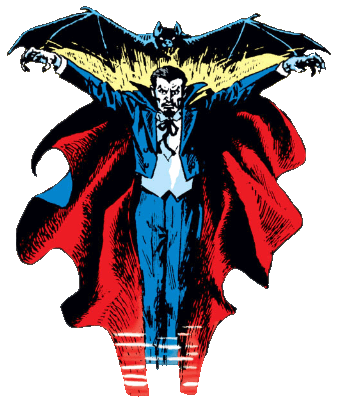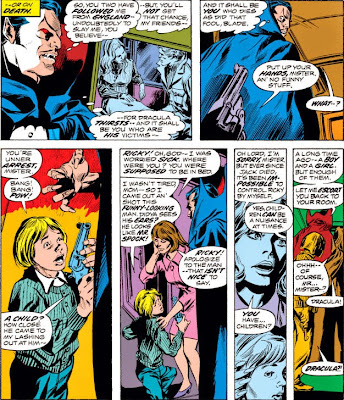In the '70s series Tomb Of Dracula, artist Gene Colan and several others contributed to those wonderful covers depicting Dracula as menacing, or enraged, or in some other threatening state which attempted to avoid mimicking previous covers--a tall order, considering that Dracula was obviously the main draw of the book and it was important for him to be prominently featured on the cover in some capacity, different yet still resembling the dangerous vampire readers were plunking down change to see.
Yet one Tomb cover artist who made no small contribution in this respect was Gil Kane, who depicts horror quite nicely and whose touch on a Dracula cover was certainly eye-catching:
| Tomb of Dracula #17, featuring another Kane-pencilled cover, was one of the transition issues leading up to Dracula's confrontation with Doctor Sun, the disembodied brain who sought to make Dracula's powers his own and, from there, move on to conquering the world. As is implied by its cover, the main story takes place on a train, bound for Transylvania, with several other players who have business with Dracula in one way or another. Dracula, for his part, wishes to pass the 500-mile journey uneventfully, avoiding pursuit from Quincy Harker and his associates. But two of those characters--Rachel Van Helsing and Frank Drake--have already guessed correctly as to what Dracula's next move was likely to be: |
There is also a mysterious character from Germany, Ludwig Gruber, who, like Dracula, wishes to keep a low profile, and has apparently hired Jacque Granét, a French bodyguard, to ensure his safety from those whom he feels certain are after him:
One of Harker's group who won't be aboard this train is the rogue vampire hunter, Blade, who attempts to intercept Dracula in Paris--and it's with this confrontation that the story opens, immediately ramping up the tension level with a fight that Blade intends to be his last with the Lord of Vampires:
Unfortunately, Blade will get his wish.
Blade's abilities have always been, as Dracula might put it, "good for show," since he's an able, resourceful fighter who sports wooden knives that would prove deadly to any vampire. Writer Marv Wolfman has done a fair job of making Blade a noteworthy character--yet Blade's characterization and past have always been more interesting than in what he brings to the table as a threat to Dracula. For one thing, no fighter in his right mind would wear shades to battle a creature of the night, thus making it more difficult for himself to pinpoint a fast and shifting target who's been at home in the darkness for hundreds of years. As for Blade's weaponry--make that "weapon"--a knife will come in handy when he has his opponent at a disadvantage, true; but Blade has neither the strength nor the speed to bring that about on his own, and usually has more success when he's fighting alongside others.
So in this particular skirmish, Blade, as usual, talks a good fight, but that's as far as it goes--and an end is finally brought to a character who, despite the outfit and the attitude, never realistically stood a chance against this foe:
To add insult to inj... er, death, Blade's goal of denying Dracula his resting place is also foiled, when Dracula manages to reach another coffin in Versailles.
From there, we join Dracula on board the train, where, later, a youngster's roleplaying leads to an act that will deny Dracula any hope of keeping his enemies unaware of him. Not that Dracula is exactly the cowering type:
Gruber is now convinced that Dracula (though he doesn't yet know him as such) has been sent to retrieve him as well as the case of documents he grips so resolutely. And, whatever reason he's on the run, Gruber's fear and paranoia seem to make him as dangerous to those aboard as Dracula:
Yet Granét's gun, as you might imagine, makes him even less of a threat to Dracula than Blade--and when he tracks Dracula to his stateroom, this former French underground fighter meets a similar fate, with Dracula, knowing nothing of Gruber at this point, assuming the man is one of Harker's people:
It doesn't then take long for Drake and Van Helsing to track down Dracula. And while Van Helsing might present a minor threat to Dracula, the same will never be true of the posturing Drake, whom Dracula sizes up with a string of insults that aren't too far from the truth:
Once he evades Van Helsing, Dracula decides that the train is close enough to Transylvania for him to *ahem* wing it there on his own. Which might have worked out for Gruber, since, in reality, there is no one we've met aboard this train who's actually after him. Until, that is, he stupidly confronts Dracula, and thus puts himself squarely in the vampire's sights:
And so we learn that Gruber was in some way involved with Doctor Sun's plans for Dracula, and was presumably on the way to the proper authorities with documentation on Sun's entire operation--papers that, with Gruber's suicide, would instead be found and retrieved by Sun's men.
The twist ending, if you can call it that, is arguably the only thing (aside from the death of a "major" character) that this story has to redeem itself--though that assessment isn't meant to label the tale as pointless or weak. Those words might instead be applied to Drake and Van Helsing, who almost always act like confident hunters who have Dracula on the run but who have a habit of folding like a cheap suit when it comes time to prove their mettle. The story in general, though, is able to stand on its own; even as a link in a chain of stories meant to build anticipation for the confrontation with Sun, it has other segments that allow Dracula to be featured well.
As for Van Helsing, who hung back a little in this tale, you can see her receive more of a spotlight in facing Dracula in a subsequent issue, taking place just before Dracula finally meets up with Sun.
 | Tomb of Dracula #17 Script: Marv Wolfman Pencils: Gene Colan Inks: Tom Palmer Letterer: John Costanza |



















4 comments:
I was recently reading "Deadpool: Dracula's Gauntlet" which was excellent in my opinion (I love Deadpool) but there was one big disappointment namely Dracula looked absolutely nothing like the '70s version. It also featured characters like Blade, the Frankenstein monster, Werewolf by night and Modok who were all unchanged so I don't understand the big idea of making Dracula so different.
To tell you the truth, Colin, as much as I liked Colan's Dracula, I really didn't understand why Colan never varied his look in the slightest; for example, he seldom if ever had the man remove his cloak, even when he sat down to write his journals. And with a 70-issue run, it's easy to see why people associate that style as the way Dracula should look in any subsequent Marvel appearances--it became a very definitive look for him. Consequently, I really don't mind when other artists want to break away from that and, for instance, draw him bearded, or with more pallor, or with different colored clothing. As long as they manage to keep his overall regal bearing, it's interesting to me to see how others perceive him.
The Dracula in Deadpool had long white hair, pointy ears with two huge gold (I guess they were gold) discs as earrings and he was wearing armour - I think they were going for some kind of medieval eastern European look.
Dracula appeared in something in the early 80's, I think it was Doctor Strange and Thor, and his appearance was significantly different even then, and I have to say, it annoyed much. I think his mustache was much fuller, for one, and he looked a bit Latino to my eyes. I didn't notice any explanation as to the appearance change, either.
Post a Comment